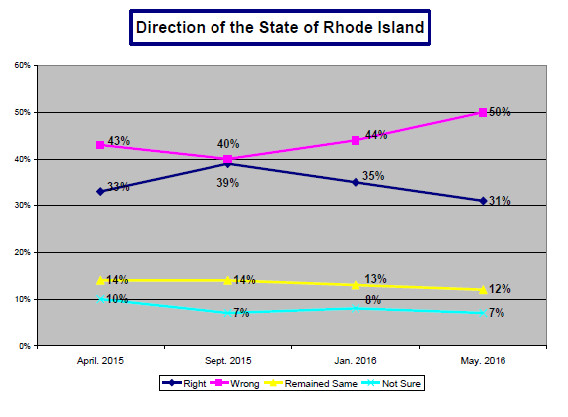
SMITHFIELD – Rhode Islanders gave the state’s public school system a collective C in the latest Hassenfeld Institute for Public Leadership poll. At the same time, roughly half of the poll respondents said that the state was moving in the wrong direction, a 25 percent increase in that negative impression from eight months ago.
The institute, located at Bryant University, released the results of its fifth survey since 2014 on Thursday. The institute queried 403 registered Rhode Island voters at the end of April and the beginning of May on their attitudes toward public education and the direction of the state.
Asked to grade the public school system, 7.2 percent of survey respondents gave the system an A, 29.8 percent gave it a B, 32.3 percent judged it as a C, 12.9 percent gave it a D, 6.4 percent believe the system is failing and 4.2 percent weren’t sure.
Sixty-seven percent of Rhode Islanders believe there is too much of an emphasis on standardized testing, while 25.5 percent said there is too little (7.9 percent were not sure).
At the same time, there was no agreement as to whether the state Department of Education was exercising enough oversight of local school districts – 21.6 percent of respondents said RIDE exercised too much oversight, 26.3 percent said too little, 22.8 percent said state involvement was just right, and 29.3 percent were not sure.
Further questions asked how important specific initiatives should be to the state:
- 72.5 percent said that improving teacher training and professional development was “very important”
- 66.7 percent said it was very important to expand programs for under-achieving students
- 57.3 percent said higher student and school performance standards were very important
- Increasing principals’ authority on what happens at school was viewed as very important by 47.6 percent of respondents
- A plurality – 39.5 percent – of those answering the questions said expanding school choice was very important.
In addition, 52.4 percent said they were in favor of a constitutional amendment that would make education a fundamental right even if there were costs attached.
As for the direction of the state, 49.6 percent of respondents said that Rhode Island is headed in the wrong direction. That number is an increase from 44 percent in January and 40 percent in September 2015. At the same time, 31 percent said Rhode Island is headed in the right direction, a decline from 35 percent in January and 39 percent in September, when positive and negative feelings were roughly the same.
Conducted by Fleming and Associates the poll was conducted between April 30 and May 3. The margin of error is plus or minus 4.9 percent.













Blackstone Valley Prep Charter School is successful because everyone in the school is working together as a team on a daily basis. Because of the lottery system of choosing students, every parent and other family members of charter school students are motivated to work together to make the charter school successful. A large number of students in a charter school are low income and underprivileged. Their home life is not stable and these students change neighborhoods frequently. Normally these students would be attending many different schools. However, in a charter school, these students are provided with a stable learning environment. Every day these students are surrounded by the same administrators, teachers and classmates who care about and want to help one another. The daily lessons are well planned and these students have the opportunity to learn the basic skills on a day to day basis. There are few interruptions in the learning stream. I say, “Let’s provide a stable learning environment for low income, underprivileged public school students.” When the parents of these children are forced to move to a new local neighborhood or a new town, these children should not be forced to change schools. These children should be allowed to stay with the administrators, teachers and students who know and care about them.